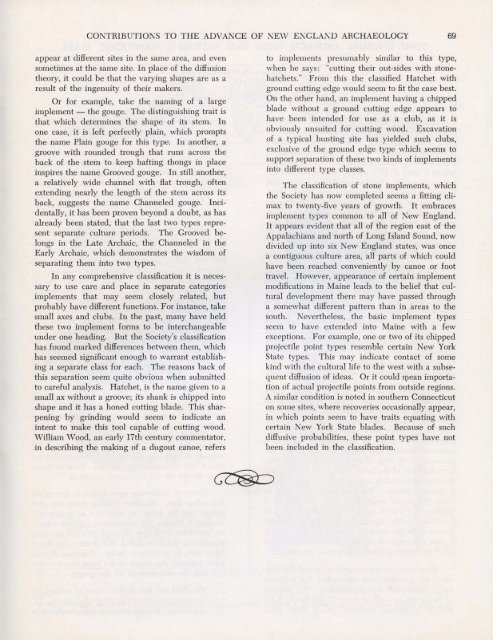Bulletin of the Massachusetts Archaeological Society, Vol. 25, No. 3 ...
Bulletin of the Massachusetts Archaeological Society, Vol. 25, No. 3 ...
Bulletin of the Massachusetts Archaeological Society, Vol. 25, No. 3 ...
You also want an ePaper? Increase the reach of your titles
YUMPU automatically turns print PDFs into web optimized ePapers that Google loves.
CONTRIBUTIOl\'S TO THE ADVANCE OF NEW EI\GLAI\D ARCHAEOLOGY 69<br />
appear at different sites in <strong>the</strong> same area, and even<br />
sometimes at <strong>the</strong> same site. In place <strong>of</strong> <strong>the</strong> diffusion<br />
<strong>the</strong>ory, it could be that <strong>the</strong> varying shapes are as a<br />
result <strong>of</strong> <strong>the</strong> ingenuity <strong>of</strong> <strong>the</strong>ir makers.<br />
Or for example, take <strong>the</strong> naming <strong>of</strong> a large<br />
implement - <strong>the</strong> gouge. The distinguishing trait is<br />
that which determines <strong>the</strong> shape <strong>of</strong> its stem. In<br />
one case, it is left perfectly plain, which prompts<br />
<strong>the</strong> name Plain gouge for this type. In ano<strong>the</strong>r, a<br />
groove with rounded trough that runs across <strong>the</strong><br />
back <strong>of</strong> <strong>the</strong> stem to keep hafting thongs in place<br />
inspires <strong>the</strong> name Grooved gouge. In still ano<strong>the</strong>r,<br />
a relatively wide channel with flat trough, <strong>of</strong>ten<br />
extending nearly <strong>the</strong> length <strong>of</strong> <strong>the</strong> stem across its<br />
back, suggests <strong>the</strong> name Channeled gouge. Incidentally,<br />
it has been proven beyond a doubt, as has<br />
already been stated, that <strong>the</strong> last two types represent<br />
separate culture periods. The Grooved belongs<br />
in <strong>the</strong> Late Archaic, <strong>the</strong> Channeled in <strong>the</strong><br />
Early Archaic, which demonstrates <strong>the</strong> wisdom <strong>of</strong><br />
separating <strong>the</strong>m into two types.<br />
In any comprehensive classification it is necessary<br />
to use care and place in separate categories<br />
implements that may seem closely related, but<br />
probably have different functions. For instance, take<br />
small axes and clubs. In <strong>the</strong> past, many have held<br />
<strong>the</strong>se two implement forms to be interchangeable<br />
under one heading. But <strong>the</strong> <strong>Society</strong>'s classification<br />
has found marked differences between <strong>the</strong>m, which<br />
has seemed significant enough to warrant establishing<br />
a separate class for each. The reasons back <strong>of</strong><br />
this separation seem quite obvious when submitted<br />
to careful analysis. Hatchet, is <strong>the</strong> name given to a<br />
small ax without a groove; its shank is chipped into<br />
shape and it has a honed cutting blade. This sharpening<br />
by grinding would seem to indicate an<br />
intent to make this tool capable <strong>of</strong> cutting wood.<br />
William \Vood, an early 17th century commentator,<br />
in describing <strong>the</strong> making <strong>of</strong> a dugout canoe, refers<br />
to implements presumably similar to this type,<br />
when he says: "cutting <strong>the</strong>ir out-sides with stonehatchets."<br />
From this <strong>the</strong> classified Hatchet with<br />
ground cutting edge would seem to fit <strong>the</strong> case best.<br />
On <strong>the</strong> o<strong>the</strong>r hand, an implement having a chipped<br />
blade without a ground cutting edge appears to<br />
have been intended for use as a club, as it is<br />
obviously unsuited for cutting wood. Excavation<br />
<strong>of</strong> a typical hunting site has yielded such clubs,<br />
exclusive <strong>of</strong> <strong>the</strong> ground edge type which seems to<br />
support separation <strong>of</strong> <strong>the</strong>se two kinds <strong>of</strong> implements<br />
into different type classes.<br />
The classification <strong>of</strong> stone implements, which<br />
<strong>the</strong> <strong>Society</strong> has now completed seems a fitting climax<br />
to twenty-five years <strong>of</strong> growth. It embraces<br />
implement types common to all <strong>of</strong> New England.<br />
It appears evident that all <strong>of</strong> <strong>the</strong> region east <strong>of</strong> <strong>the</strong><br />
Appalachians and north <strong>of</strong> Long Island Sound, now<br />
divided up into six New England states, was once<br />
a contiguous culture area, all parts <strong>of</strong> which could<br />
have been reached conveniently by canoe or foot<br />
travel. However, appearance <strong>of</strong> certain implement<br />
modifications in Maine leads to <strong>the</strong> belief that cultural<br />
development <strong>the</strong>re may have passed through<br />
a somewhat different pattern than in areas to <strong>the</strong><br />
south. Never<strong>the</strong>less, <strong>the</strong> basic implement types<br />
seem to have extended into Maine with a few<br />
exceptions. For example, one or two <strong>of</strong> its chipped<br />
projectile point types resemble certain New York<br />
State types. This may indicate contact <strong>of</strong> some<br />
kind with <strong>the</strong> cultural life to <strong>the</strong> west with a subsequent<br />
diffusion <strong>of</strong> ideas. Or it could I1lean importation<br />
<strong>of</strong> actual projectile points from outside regions.<br />
A similar condition is noted in sou<strong>the</strong>rn Connecticut<br />
on some sites, where recoveries occasionally appear,<br />
in which points seem to have traits equating with<br />
certain New York State blades. Because <strong>of</strong> such<br />
diffusive probabilities, <strong>the</strong>se point types have not<br />
been included in <strong>the</strong> classification.

















